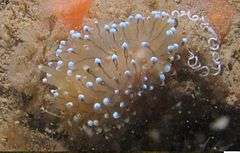Janolus cristatus
| Janolus cristatus | |
|---|---|
| | |
| Janolus cristatus, head end towards the top of the image | |
| Scientific classification | |
| Kingdom: | Animalia |
| Phylum: | Mollusca |
| Class: | Gastropoda |
| (unranked): | clade Heterobranchia clade Euthyneura |
| Family: | Proctonotidae |
| Genus: | Janolus |
| Species: | J. cristatus |
| Binomial name | |
| Janolus cristatus (Delle Chiaje, 1841) | |
| Synonyms | |
|
Antiopa splendida Alder & Hancock, 1848
| |
Janolus cristatus, sometimes known by the common name crested aeolis, is a species of nudibranch, a marine gastropod mollusk in the family Proctonotidae.[1]
Taxonomy
Some authors assign the genus Janolus to the Janolidae family (see ITIS.gov [2] or AnimalDiversity[3]), other (see Seaslug[4]) to the family of Zephyrinidae, that are synonymised names of Proctonotidae' (see WoRMS). [5]
Description
This rare species is semi-transparent and has an oval-shaped outline. It is cream or light brown in colour, and grows to approximately 7.5 cm in length. The head has oral tentacles that are short.[6]
The lateral cerata are numerous, have a smooth surface and an inflated appearance. The central digestive gland lobe is thin and brown in colour and can be seen through each ceras. These gland lobes divide at the tip of the cerata into numerous terminal branches. The tips of the cerata are bluish-white and iridescent.[7]
This white colouration that is present on the cerata also appears in patches or lines along the bare central dorsum, as well as around the lamellate rhinophores and on the metapodium. The rhinophores are joined together at their bases with a swollen and wrinkled accessory caruncle. Both the rhinophores and median sensory caruncle are somewhat darker in colour than the rest of the body.[6]
Distribution
Janolus cristatus has been found as far north as Norway down through the British Isles and the French Atlantic coast.[6] It has also been recorded in Moroccan waters as well as in the western Mediterranean Sea.[7][8]
Habitat
It is found at depths of up to 40 metres, only in calm, clean water, on hard substrata in the sublittoral zone.[6]
Biology
Janolus cristatus eats erect bryozoan of the species Alcyonidium gelatinosum, Bicellariella ciliata and in the Bugula genus, such as B. turbinata, B. plumosa, B. neritina] and possibly species in the Cellaria genus.[7]
The spawn of this species appear as a light pink or white string forming a wavy, circular pattern. The eggs themselves are contained within packets with transparent patches in between. This gives them the appearance of beads.[7]
Gallery
 Janolus cristatus depositing eggs
Janolus cristatus depositing eggs- Janolus cristatus in the Ligurian Sea (Levanto)
.jpg) J. cristatus on Reteporella grimaldii
J. cristatus on Reteporella grimaldii- Two J. cristatus crawl across the bottom. Video clip
Bibliography
- Gary R. McDonald Nudibranch Systematic Index (2nd ed.), University of California Santa Cruz University of California Santa Cruz in Institute of Marine Sciences, (2009).
- Gary R. McDonald, James W. Nybakken, A List of the Worldwide Food Habits of Nudibranchs, in University of California Santa Cruz.
- R. Cattaneo-Vietti, R. Chemello et R. Gianuzzi-Savelli, Atlas of Mediterranean nudibranchs, Roma, Editrice La Conchiglia, 1990, 264 p. (OCLC 26035712, LCCN 93155161)
- Thomas E. Thompson et G.H. Brown, Biology of Opisthobranch Molluscs : The standard work on British nudibranchs, with up to date information and colour paintings of nearly all species, vol. 2, Ray Society, 1984 (ISBN 0903874180)
- Delle Chiaje, S. (1841). Descrizione e notomia degli animali invertebrati della Sicilia citeriore osservati vivi negli anni 1822-1830, Napoli, 7: pls. 86-173 (Nudibranchia pls. 88, 89, 100, 106, 178). Text in vol. 8, p. 6 (1844)
- Egidio Trainito, Nudibranchi del Mediterraneo. Guida al riconoscimento dei molluschi opistobranchi, 2005ª ed., Milano, Il Castello, 2005, ISBN 88-8039-438-X.
External links
| Wikimedia Commons has media related to Janolus cristatus. |
References
- ↑ "WoRMS - World Register of Marine Species - Janolus cristatus (Delle Chiaje, 1841)". Marinespecies.org. 2004-12-21. Retrieved 2014-05-24.
- ↑ IT IS Report
- ↑ IT IS Report Animal Diversity
- ↑ The Sea Slug Forum Australian Museum
- ↑ Proctonotidae at WoRMS
- 1 2 3 4 "Marine Species Identification Portal : Janolus cristatus". Species-identification.org. Retrieved 2014-05-24.
- 1 2 3 4 "Janolus cristatus - Marine Life Encyclopedia". Habitas.org.uk. Retrieved 2014-05-24.
- ↑ Thomas E. Thompson, Molluscs: Benthic opisthobranchs, Leiden, Brill, coll. « Synopses of the British Fauna » (no 8), 1988 (ISBN 9004084398)